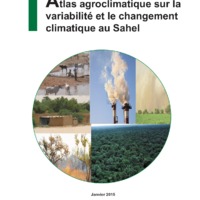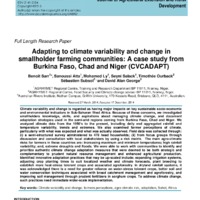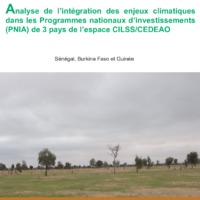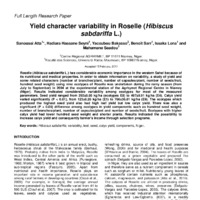Recherche
5 items
Atlas agroclimatique sur la variabilité et le changement climatique au sahel
L’atlas abrite, en effet, un socle d’informations importantes sur la variabilité et les changements climatiques au Sahel. L’état du réchauffement climatique, la variabilité accrue des pluies, le dysfonctionnement des paramètres de la saison des pluies, la recrudescence des phénomènes climatiques et météorologiques extrêmes (vague de chaleur, sécheresse, fortes pluies), les impacts du changement climatique sur les cultures, la voie à emprunter en matière d’agriculture mieux réfléchie face au climat sont autant d’informations qui y sont illustrées. Il fournit, en effet, des pistes et de recettes sur la manière d’agir à court, moyen et long terme pour adapter les secteurs clés au changement climatique. Enfin, cet atlas qui a pour ambition de toucher une large communauté d’utilisateurs est traduit en langage clair et compréhensible par tous.
Adapting to climate variability and change in smallholder farming communities: a case study from Burkina faso, Chad and Niger
Climate variability and change is regarded as having major impacts on key sustainable socio-economic and environmental indicators in Sub-Saharan West Africa. Because of these concerns, we investigated smallholders knowledge, skills, and aspirations about managing climate change, and document adaptation strategies used in the semi-arid regions coming from Burkina Faso, Chad and Niger. We analyzed climate data from the 1950’s to the present, including daily and aggregated rainfall and temperature variability, trends and extremes.
Analyse de l’intégration des enjeux climatiques dans les programmes nationaux d’investissements (pnia) de 3 pays de l’espace cilss/cedeao
Analyse de l’intégration des enjeux climatiques dans les Programmes nationaux d’investissements (PNIA) de 3 pays de l’espace CILSS/CEDEAO
VARIATION IN MACRO-ELEMENTS AND PROTEIN CONTENTS OF ROSELLE (HIBISCUS SABDARIFFA L.) FROM NIGER
Roselle is an important part of the human diet in many countries, particularly in the Sahel zone of West Africa. The leaves of Roselle are consumed as a green vegetable and in sauce. Nevertheless, little attention has been paid to their nutrient composition at different stages of plant growth. Therefore, an experiment was carried out under rainfall conditions from July to September 2006 at the experimental station of the Agrhymet Regional Centre in Niamey (Niger). The contents of Ca, K, Mg, P and protein in leaves of three ecotypes (A3, A7 and A9) were determined at stages I, II and III, corresponding, respectively to vegetative, flowering and mature stages. The experimental design was a randomized complete block with four replicates and one variable (ecotype). For ecotype A7, the protein content of the leaves decreased significantly (p<0.05) between stage I and II, than remained relatively constant up to stage III. In contrast for A3 and A9, protein content in leaves decreased significantly (p<0.05) between stage II and III. From stage I to III, the decrease of protein content in leaves was 41& for ecotype A3, 50& for A7 and 66& for A9. For all ecotypes, the P content of the leaves decreased progressively during plant growth. For A7 and A9, the reduction in P content from stage I to II and from II to III was about the same, namely 30&. However, for ecotype A3, the decrease was greater, respectively, 37& and 46&. The Mg content of the leaves was relatively constant for all three ecotypes at a given stage of plant development. However, the Mg content of the leaves decreased significantly (p<0.05) from flowering to maturity: 28& for A3, 23& for A9 and 14& for A7. For the three ecotypes, the Ca content of the leaves remained relatively constant from stage I to II, than increased markedly from stage II to III, to about 150& for A7, 85& for A3 and 50& for A9. From stage I to II, the leaves’ K content decreased significantly for all three ecotypes, about 67& for A9, 62& for A3 and 44& for A7. The data indicated that Roselle can contribute useful amounts of essential nutrients such as Ca K, Mg, N and P mainly at vegetative stage in the diets of people who inhabit the western Sahel.
Yield character variability in Roselle (Hibiscus sabdariffa L.)
Roselle (Hibiscus sabdariffa L.) has considerable economic importance in the western Sahel because of its nutritional and medical properties. In order to obtain information on variability, a study of yield and some related characters (number of branches/plant, number of capsules/plant, number of seeds/fruit, hundred seed weight) using nine ecotypes of Roselle was undertaken during the rainy season (from July to September) in 2004 at the experimental station of the Agrhymet Regional Centre in Niamey (Niger). Results indicated considerable variability among ecotypes for most of the measured parameters. Seed yield ranged from 292±8.80 kg/ha (ecotypes E8) to 497±8.91 kg/ha (E4). Calyx yield varied significantly (P < 0.01), from 123±8.26 kg/ha (E1) to 766±36.81 kg/ha (E9). The ecotypes which produced the highest seed yield also had high leaf yield but low calyx yield. There was also a significant (P < 0.05) difference among ecotypes in yield components such as hundred seed weight, number of branches/plant, number of capsules/plant and number of seeds/fruit. Ecotypes with higher calyx yield had lower hundred seed weight and shorter plants. Results indicated the possibility to increase calyx yield and consequently farmer’s income through selection programs.




